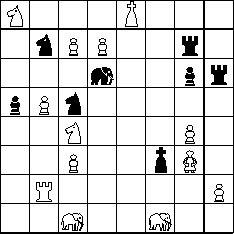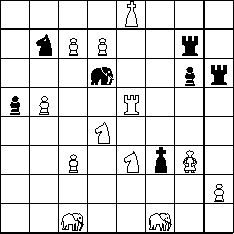Check out McCooey's Hexagonal Chess, our featured variant for May, 2025.

Check out McCooey's Hexagonal Chess, our featured variant for May, 2025.
 White:
White:
King e8; General g3; Rook b2; Knight a8, c4; Elephant c1, f1; Pawns b5,
c3, c7, d7, g4, h2. (13 pieces)
Black:
King f3, Rook g7, h6; Knight b7, c5; Elephant d6; Pawns a5, g6. (8 pieces).
White to play and win.
The original diagram does not have a white pawn on c7, and allows a shorter solution: when white would play in his third move N a8 - c7, it would be mate. This was not the intention of the original composers, as the old manuscripts carry the longer solution with them.
1. N c4-e5+, K f3-e4
2. R b2-e2+, K e4-d5
3. N a8-b6+, K d5-e6
4. N e5-c6+, N c5-e4 (or see below)
5. R e2xe4+, K e6-f6
6. N b6-d5+, K f6-g5
7. R e4-e5+, K g5xg4
8. N d5-e3+, K g4-f3
9. N c6-d4+, mate
If black would move 4. ..., K e6 - f6, we have, similar as above: 5. N b6-d5+, K f6-g5. 6. R e2-e5+, K g5xg4. 7. N d5-e3+, Kg4-f3. 8. N c6-d5, mate.
 Mating
position. If black has played 4. ..., K e6-f6, there is an additional black
knight on c5.
Mating
position. If black has played 4. ..., K e6-f6, there is an additional black
knight on c5.